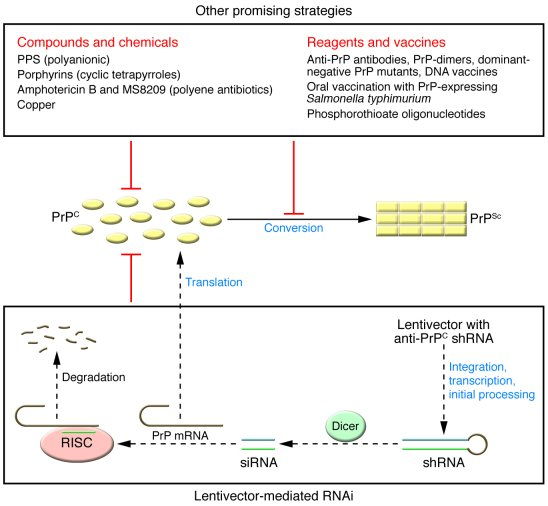Prion disease treatment is an emerging field of research that could potentially change the outlook for individuals affected by these devastating disorders. Prion diseases, known for their fatal outcomes and caused by misfolded proteins in the brain, have long troubled both patients and researchers alike. Recent advancements in gene editing therapy hold promise, revealing that altering a single base in the prion protein gene significantly reduces harmful protein levels in laboratory mice. This groundbreaking work, highlighted by Sonia Vallabh and Eric Minikel, is not only a scientific endeavor but a deeply personal mission fueled by the authors’ own experiences with fatal familial insomnia. With ongoing clinical trials for prion diseases, the scientific community remains hopeful for innovative treatments that could lead to better outcomes for patients.
The exploration of therapies for prion-related diseases, which include genetic mutations and rare disorders like fatal familial insomnia, has gained increased momentum in recent years. By investigating the complexities of misfolded proteins that cause substantial neurological damage, researchers are now employing techniques such as gene manipulation and clinical trials aimed at combating these dire conditions. This novel approach not only sheds light on the pathophysiology of these diseases but also paves the way for innovative treatment options. The collaborative efforts among patient-scientists and experts could revolutionize how we understand and address these devastating ailments, which historically have been viewed as untreatable. As foundational research continues to progress, the prospect of effective genetic therapies expands, offering hope where there has long been despair.
Understanding Prion Diseases and Their Impact
Prion diseases, such as Creutzfeldt-Jakob disease and fatal familial insomnia, represent a group of neurodegenerative disorders caused by abnormal protein folding. These diseases are characterized by progressive brain damage, leading to severe cognitive decline and ultimately, increased mortality rates. The complexity of these diseases arises not only from their varied origins—15% are linked to genetic mutations, while 85% occur sporadically due to spontaneous misfolding—but also from the completely untreatable nature of the conditions until recently. Understanding the underlying mechanisms of prion diseases is essential for developing effective treatments.
Recent advances in prion disease research have provided much-needed hope to affected families. As studies continue to explore the relationship between protein misfolding and neuronal damage, scientists are beginning to see pathways that could lead to effective therapeutic strategies. For those like Sonia Vallabh, whose personal connection to fatal familial insomnia drives her research, the exploration of new treatments is not just a professional endeavor but a battle for survival.
The Promise of Gene Editing Therapy in Prion Disease Treatment
Gene editing therapy represents a groundbreaking approach in the treatment of prion diseases. Specifically, the development of technology that enables the precision editing of genes responsible for producing harmful prion proteins is paving the way for innovative therapeutic options. Research led by the Broad Institute has shown that altering a single base in the prion protein gene can drastically reduce harmful protein levels in the brains of mice, thereby extending their lifespans significantly. This milestone hints at the potential for similar applications in human subjects if clinical trials for prion diseases can be successfully initiated.
However, the journey from promising lab results to human application is fraught with challenges. Scientists must thoroughly evaluate the safety and efficacy of such cutting-edge therapy through rigorous clinical trials before it can be deemed a reliable treatment option. The collaborative efforts of researchers have emphasized the necessity for meticulous monitoring and evaluation processes to ensure that these treatments will benefit patients while minimizing risks.
Current Research Developments in Prion Disease Management
Research into prion diseases is gaining momentum, partly due to the personal narratives of those involved in the studies. The work of patient-scientists, such as Vallabh and Minikel, has highlighted a deep-seated motivation to accelerate the research process. Their lab, which focuses on gene editing and the implications of prion proteins in disease progression, serves as a testament to how personal experiences can power groundbreaking scientific inquiry. As trials move forward, the integration of personal motivation with scientific rigor can lead to faster advancements in the field.
Clinical trials for prion diseases are essential for validating the therapeutic methods being developed in research labs. Nonetheless, the path towards these trials is challenging as researchers must navigate technical hurdles such as the safe delivery of gene-editing technologies to target cells and reduce the risks of unintended consequences. As seen in recent studies, the collaboration across various scientific disciplines is critical to overcoming these obstacles and bringing hope to those affected by these devastating conditions.
The Role of Proteins in the Brain and Prion Disease Pathogenesis
Central to the discussion of prion diseases is the role of proteins in the brain. These diseases, characterized by misfolded proteins, prompt abnormal behavior that leads to neurodegeneration. Proteins like the prion protein, through their structural configurations, play decisive roles in cellular communication and function. When these proteins misfold, they interact improperly with surrounding cellular structures, resulting in a cascade of neurotoxic events that destroy brain tissue.
Understanding protein dynamics in the brain is vital for researchers working to develop therapies for prion diseases. By focusing on how these proteins can misfold and aggregate, scientists can design effective interventions. Innovative techniques, such as gene editing therapy, aim to disrupt the faulty production of these proteins at the genetic level, providing a fundamentally novel approach to halting the progression of prion disease.
Collaboration in Prion Disease Research
Collaboration is a cornerstone of progress in prion disease research. Scientists from varied disciplines come together to share insights, technologies, and approaches to tackle the complex challenges posed by these diseases. Initiatives involving multiple research organizations leverage diverse expertise, as seen in the efforts of Vallabh and Minikel, who combine their healthcare backgrounds with scientific research to push boundaries in the field of prion disease treatment.
The synergy created through such collaborations not only enriches the research but also inspires a sense of urgency among participants. The involvement of researchers who have personal stakes in the outcomes fosters an environment where each experiment and trial is driven by heartfelt motivation, ultimately aiming for the development of effective therapies for future patients.
The Challenges of Bringing Treatments from Lab to Clinic
Transitioning from laboratory breakthroughs to clinical therapies for prion diseases poses significant challenges. While several promising avenues have emerged in recent research, health regulatory processes are essential to ensure any new treatment does not compromise patient safety. Reviews, ethical considerations, and careful planning are all critical steps in this transition phase.
Each new breakthrough requires not just scientific ingenuity but also strategic foresight in trial design and patient selection. Researchers are tasked with the responsibility of determining appropriate dosing, potential side effects, and the ideal patient populations for initial trials. It is through these meticulous processes that concepts developed in the lab can eventually materialize as lifesaving treatments for patients struggling with these harrowing diseases.
Impact of Fatal Familial Insomnia on Research Motivation
Fatal familial insomnia is one of the most tragic forms of prion disease, highlighting the personal stakes for many researchers. For individuals like Sonia Vallabh, who has a familial history rooted in this devastating condition, the drive to find effective treatments is not merely professional—it is deeply personal. Her journey underscores how real-life experiences can catalyze the passion needed to fuel significant scientific endeavors.
Such emotional connections to research projects manifest in remarkable dedication among scientists, who work tirelessly to harness their expertise towards finding solutions. The hope is that through their efforts, not only the scientific community but also affected families can find respite in therapies that extend life and improve quality of living for those grappling with prion diseases.
Ethical Considerations in Prion Disease Research
The pursuit of effective treatments for prion diseases is intertwined with ethical considerations that must be addressed. As researchers explore gene editing therapies, transparency in the process is vital. Ensuring informed consent and understanding the potential implications of genetic modifications are paramount to maintaining ethical standards in research and clinical applications.
Additionally, the history of prion disease research includes instances of laboratory accidents and ethical dilemmas regarding human exposure to prion proteins. These past experiences serve as crucial lessons for contemporary scientists. By acknowledging these challenges and embracing ethical guidelines, researchers can pave a responsible path that respects both scientific discovery and patient welfare.
Future Projections for Prion Disease Treatments
Looking ahead, the future of prion disease treatments paints an optimistic picture. With advancements in gene editing therapy and a committed cadre of researchers, the possibility of developing effective interventions seems increasingly attainable. Ongoing studies aim to refine purification processes, enhance vector efficiency, and bolster the safety profiles of potential therapies, ushering in a new era for patients affected by prion conditions.
As the field progresses, continued collaboration, thorough clinical trial designs, and unwavering dedication from the scientific community will be crucial to realize the vision of accessible, life-saving treatments for those suffering from debilitating prion diseases. The journey from lab to clinic will be meticulous, but with every milestone achieved, the hope for a cure remains a driving force.
Frequently Asked Questions
What are the current advancements in prion disease treatment using gene editing therapy?
Recent advancements in prion disease treatment focus on gene editing therapy that modifies the genetic instructions responsible for producing harmful prion proteins. A study published in Nature Medicine demonstrated that altering one base in the prion protein gene reduced protein levels in laboratory mice, extending their lifespans by 52%. This breakthrough offers hope for effective therapies against prion diseases in the future.
How does gene editing therapy contribute to prion disease research?
Gene editing therapy significantly contributes to prion disease research by offering a potential method to correct the genetic mutations that cause these fatal conditions. This innovative approach, particularly the single base editing technique, holds promise for developing treatments that could reduce the levels of toxic proteins in the brain, which are central to the pathology of prion diseases.
What is the significance of clinical trials for prion diseases?
Clinical trials for prion diseases are crucial as they are essential steps in transitioning from laboratory findings to potential treatments for humans. These trials will assess the safety and efficacy of gene editing therapies aimed at curtailing the production of toxic prion proteins, ultimately providing hope for patients suffering from conditions like fatal familial insomnia and Creutzfeldt-Jakob disease.
Can gene editing therapy be a future cure for fatal familial insomnia?
While it is too early to claim that gene editing therapy will be a cure for fatal familial insomnia, recent research shows promise. By effectively reducing levels of toxic prion proteins associated with the disease, gene editing could lead to significant improvements in patient outcomes, although more research and clinical trials are needed to establish its viability as a treatment.
What role do proteins in the brain play in prion diseases?
In prion diseases, misfolded proteins in the brain, primarily the prion protein, lead to brain damage and cognitive decline. These abnormal proteins induce other normal proteins to misfold, creating a chain reaction that results in neurodegenerative conditions. Understanding the role of these proteins is crucial for developing effective treatments and therapies.
What challenges do researchers face in developing treatments for prion diseases?
Researchers face several challenges in developing treatments for prion diseases, including the inherent complexity of the diseases, the infectious nature of prion proteins, and the need for extensive safety measures in clinical trials. Moreover, base editing technology must be refined to ensure targeted delivery and efficacy without unintended effects, which complicates the path to human application.
| Key Point | Details |
|---|---|
| Research Team | Led by David Liu at the Broad Institute, involving Sonia Vallabh and Eric Minikel, who are personally affected by prion disease. |
| Prion Diseases | Rare, fatal disorders caused by misfolded proteins in the brain, such as Creutzfeldt-Jakob disease and fatal familial insomnia. |
| Gene-Editing Breakthrough | Successful modification of a gene in mice led to a 52% increase in lifespan by halving harmful protein production. |
| Human Trials Timeline | Several steps remain before human trials can begin, estimated to be years away. |
| Collaboration Importance | The collaboration between patient-scientists and researchers enhances motivation and development of effective treatments. |
| Safety and Efficacy | Researchers are working on improving the safety profile of gene-editing vectors to ensure they do not induce illness. |
Summary
Prion disease treatment is making significant strides thanks to innovative research efforts by scientists personal to the field. The discovery of a gene-editing therapy that has shown promising results in mice could potentially lead to viable treatments for humans. By addressing the production of toxic proteins associated with prion diseases, researchers are opening doors to hope for patients and families affected by these conditions. While human trials are still some years away, the determination and collaboration between researchers and patient advocates fuel the drive to pursue effective therapies for prion diseases.




